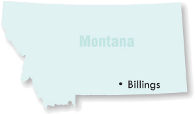
This case study relates to:
Workshops
Resource & Funding Coordination
Urban Transportation District
Transportation Utility Fee
The Setting

The City of Billings (population 100,000) is located in Southeast Montana within Yellowstone County. Healthcare, energy, financial, engineering & technical services, and agriculture are the primary industries in Billings. Billings is also home to Montana State University-Billings and Rocky Mountain College. Recreational activities and three National Parks (Yellowstone, Teton, and Glacier) are in close proximity to Billings.
The City of Billings does not have impact fees to fund transportation system improvements; they rely primarily on grant money and traditional funding sources for transportation system improvements. The arterial construction fee formula levies a fee on all properties within the city limits and the resulting revenue (approximately $3 million annually) is used specifically for constructing or reconstructing arterial roads within Billings. Assessments are based on parcel square footage and zoning to categorize properties with respect to their current or potential ability to contribute traffic to the arterial street system. For example, commercial and multi-family properties pay more because they generate more traffic. The square footage (and resulting arterial construction fee assessment) of residentially zoned properties is capped because the size of the residence does not generate additional trips. City staff used the Institute of Transportation Engineers (ITE) Trip Generation Handbook to develop trip generation rates for each generic zoning classification in the City. This effort took 3 months to complete. Arterial construction fee revenues may be used to construct or reconstruct arterial roadways within the Billings city limits.
The City instituted the arterial construction fee program in 2004 as the result of a funding gap and complaints over the assessment fees being charged property owners in Special Improvement Districts (SID). At that time, the City's existing revenue sources were not sufficient to meet the community's arterial construction and reconstruction needs. The City decided to explore other approaches to generate revenue to fund improvements to the transportation system. This arterial construction fee assessment is unique in Montana and is an example of a funding mechanism used to finance the local transportation system.
The Project
The arterial construction fee addresses the construction or reconstruction of arterial roadways within the city limits as defined within the Transportation Plan. The fee is currently administered by the public works department. Arterial construction fees are annually assessed citywide regardless of the parcel's proximity to designated arterial roadways. The arterial construction fee is a community cost, borne by all city residents. Arterial construction fee assessment rates are set annually and the assessments are included on property tax statements. The arterial construction fee assessments are collected and credited to the municipal arterial construction system fund, which is maintained by the financial services manager as a separate and special fund.
The Process

According to Montana Code Annotated, Title 7, Chapter 6, Part 16, as a self-governing entity, the City of Billings is enabled to establish impact fees to help pay for roads, water, sewer, storm water, parks, fire and police, library, and solid waste facilities.
The arterial construction fee is a financing tool that took about a year to develop. The public works department began discussing arterial construction funding constraints with the City Council. The City Council created an ad hoc committee to discuss options to address arterial construction funding constraints. The committee included City Council members, City staff, and representatives of various stakeholder groups (Home Builders Association, Billings Association of Realtors, local developers, etc.). City staff outlined arterial construction project needs, project costs, and the City's projected funding revenue. It became clear to the committee that existing arterial construction revenue sources were not sufficient to meet community needs. The committee discussed the pros and cons of implementing a citywide arterial construction fee assessment. The proposed ordinance language was developed and refined. Public meetings and service group presentations on the proposed arterial construction fee were conducted before the City Council held a public hearing and took action on the ordinance's adoption. The Billings City Council passed Ordinance 04-5300 adopting the arterial construction fees in 2004.
Lessons Learned

The success in developing the arterial construction fee in the City of Billings was the direct result of public outreach and stakeholder involvement from the beginning stages. These stakeholder groups easily could have been opponents of the arterial construction fee. Because these stakeholder groups were brought into the committee, they understood the situation and were empowered to help solve the funding problem. Their support of the process drove the development of the arterial construction fee as a mechanism for the City to effectively meet community transportation needs. The stakeholders presented and fully supported the arterial construction fee option before the City Council.
Trying this at Home
Arterial construction fees could possibly be implemented in other jurisdictions if their respective laws allow it (City Charter, municipal code, and state code).
Additional information about Billings' arterial construction fee assessments are available at: http://ci.billings.mt.us/DocumentCenter/Home/View/3666
Or you may contact
Public Works Administration
City of Billings
(406) 657-8230
Additional information about the arterial construction fee can be found in the Billings Montana City Code Sec. 22-1000 available online.
Information about the Transportation Plan is available at:
http://mt-billings.civicplus.com/index.aspx?NID=1466
Photo credits:
